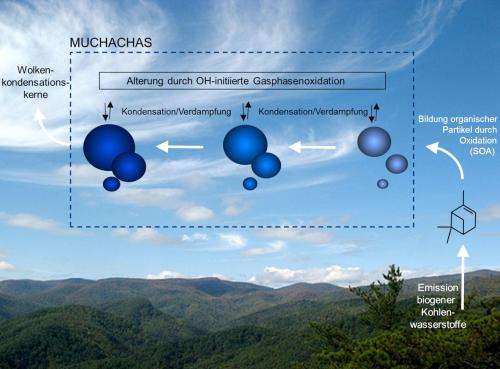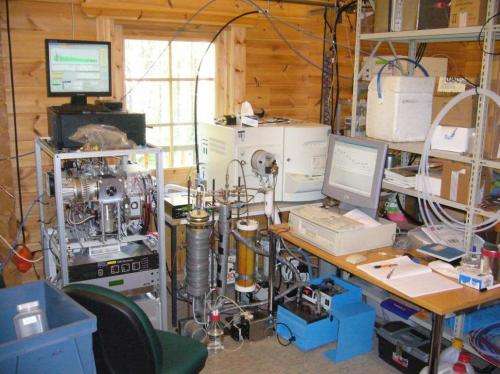Study shows that organic aerosols aging caused by OH radicals

Atmospheric aerosol particles have a significant effect on climate. An international team of researchers has now discovered that a chemical process in the atmosphere called aging determines to a major extent the concentration and the characteristics of aerosol particles. To date, this aspect has not been accounted for in regional and global climate models. In the Muchachas [Multiple Chamber Aerosol Chemical Aging Experiments] project, the team has not only managed to demonstrate the effects of aging but has also been able to measure these. Their findings have been published in the specialist journal Proceedings of the National Academy of Sciences (PNAS).
The quality of air is determined to a considerable extent by aerosol particles. In the form of a fine dust, they are believed to be responsible for a series of respiratory diseases and cardiovascular disorders. In addition, aerosol particles also have various effects on atmospheric radiation balance. Aerosols make a direct contribution to radiation levels in the cloud-free atmosphere by dispersing, reflecting, and absorbing sunlight. Aerosols are also essential for cloud formation in the troposphere: They act as condensation nuclei which even in the presence of low levels of water vapor do enable droplets to form.

The size and concentration of aerosol particles is also of great importance for the number of cloud drops, which in turn influences the reflection characteristics of clouds. Hence, aerosol particles tend to have a cooling influence on the atmosphere. However, the precise processes and feedback mechanisms have not yet been fully understood, so that the interaction between aerosol particles, their suitability as cloud condensation nuclei, and the sunlight reflected off the earth's surface represented one of the greatest uncertainties in the calculation of climatic activity.
The Muchachas project looked at organic aerosols, which constitute the largest proportion of chemical airborne particles. Organic aerosols are generated above forests, for example, and they are visible in the form of a blue mist in certain places such as the Great Smoky Mountains, the Blue Ridge Mountains, and the Blue Mountains. In densely populated areas however, anthropogenically generated and released hydrocarbons play an important role as precursor of the development of secondary organic aerosols.
The experiments showed that the mass and composition of organic aerosols are significantly influenced by OH radicals. OH radicals are the most important oxidants in the atmosphere and make an important contribution to keeping air clean. Researchers from Pittsburgh (USA), Juelich, Karlsruhe, and Mainz (Germany), Gothenburg (Sweden), Copenhagen (Denkmark), and Villigen (Switzerland) analyzed results in four different, large-volume atmospheric simulation chambers and found that the oxidation process called chemical aging has a significant impact and influence on the characteristics and concentration of organic aerosols over their entire life cycle.
"New climate models will have to take these findings into account," says Professor Dr. Thorsten Hoffmann of the Institute of Inorganic Chemistry and Analytical Chemistry at Johannes Gutenberg University Mainz (JGU) in Germany. The Mainz researchers contributed primarily to the development of analytical techniques for studying the chemical composition of the aerosol particles in the Muchachas project. Thanks to their development of so-called 'soft ionization' techniques and the corresponding mass spectrometers, Hoffmann's work group was able to track the concentration of individual molecule species in the atmospheric simulation chamber and thus observe the chemical aging of the atmospheric aerosols at the molecular level. It was clearly demonstrated that oxidation occurred in the gaseous phase and not in the particle phase. "Now the goal is to integrate these underlying reactions in models of regional and global atmospheric chemistry and so reduce the discrepancy between the expected and the actually observed concentrations of organic aerosol particles," explains Hoffmann.
More information: Donahue et al., "Aging of biogenic secondary organic aerosol via gas-phase OH radical reactions", Proceedings of the National Academy of Sciences (PNAS), 21 August 2012 doi:10.1073/pnas.1115186109
Journal information: Proceedings of the National Academy of Sciences
Provided by Universitaet Mainz



















